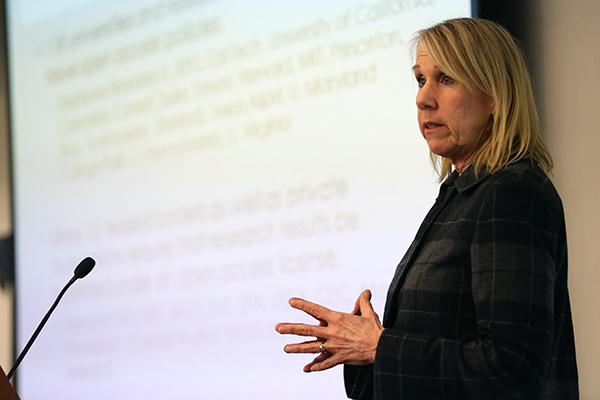Interim officials are adjusting the ways academic leadership positions are structured, months after losing the provost as well as two other high-profile leaders.
Officials announced last week that the online learning offices will be consolidated into one department, about three months after GW’s online learning director announced his departure. Faculty and experts said this reorganization is expected after the departures, which also included the head of GW’s diversity efforts, and said consolidating positions could ease fiscal concerns while continuing initiatives.
Geneva Henry, the vice provost for libraries, will oversee a new division including online teaching and learning, a combination of the online education and teaching and learning offices. Chief Academic Technologies Officer P. B. Garrett will oversee GW’s eDesign shop, which faculty can use to create their own online courses.
Interim Provost Forrest Maltzman said the choice to split the responsibilities between Henry and Garrett was obvious because Henry has “transformed” teaching and research by digital means through the libraries, and Garrett has worked closely with faculty on technologies in the past.
“We are embracing a model that capitalizes on what already existed and that will lead to a unit that is oriented to the future,” Maltzman said in an email.
‘Expanding’ online capacity
Paul Schiff Berman, the former vice provost for online learning and academic innovation, left his custom-made role at the end of last semester, and some said the position would likely be dissolved. Berman will return to the GW Law School as a full-time faculty member.
After former Provost Steven Lerman announced last fall he would step down at the end of the semester, he and other top officials said they would take the transition time to identify ways to better the way administrators in GW’s academics work together. Lerman is currently on a sabbatical and will return to GW as an endowed engineering professor.
Maltzman said he has been comparing GW’s model to other universities and has “been discussing” options for online learning and the organization of the provost’s office. He said he spoke with deans, faculty and staff when making the decision to restructure the office.
“Our goal is to continue expanding our capacity to provide online courses and will offer online education programs through the schools,” Maltzman said.
During Berman’s three-year tenure as the online learning chief, he oversaw the creation of more than 100 online degree programs, which are projected to bring in $70 million this fiscal year, according to a University release.
The eDesign shop, the University’s in-house online course office, has aimed to double the number of courses they create each year after an increased demand from GW faculty. Courses have also been updated to accommodate students with disabilities.
Officials at GW and nationwide increasingly turned to online learning in recent years. The online options are cheaper to make and bring in more revenue than in-person courses, and top administrators and faculty have pointed to online education as important key in GW’s future success, both academically and financially.
Lerman rolled out a 10-year strategic plan three years ago, highlighting online learning as a way to increase GW’s global presence.
A trusted leader in the interim
While interim leaders don’t typically make major changes to the functions of an institution, Maltzman appears to be an exception to the rule, experts say. He’s been at GW since 1993, overseeing the University’s accreditation as a faculty member nearly a decade ago, and previously served as senior vice provost for academic affairs and planning, working closely with Lerman on a daily basis.
Jay Dee, an associate professor of leadership in education at the University of Massachusetts Boston who studies organizational change in higher education, said that an interim leader who already understands the inner-workings of an institution can be trusted to make sweeping changes.
He added that when there are vacancies in an administration, it gives current officials a chance to make changes before a new leader comes in.
“Restructuring is easier when there are vacancies in roles than when there are full-time incumbents in those roles,” Dee said. “It’s easier to reallocate those positions if you don’t have a powerful individual in that administrative role.”
Lloyd Armstrong, the provost emeritus at the University of Southern California, said the president would have to support large changes like the reorganization of a top office because interims aren’t necessarily placed into permanent positions.
“But if the president said, ‘Things are not working well. What I need is a tough interim person that I would like to have made these changes,’ that would make sense,” Armstrong said.
Charles Garris, a professor of mechanical and aerospace engineering and the chair of the Faculty Senate’s executive committee who has been at GW for more than 40 years, said Lerman was key in improving and reshaping the provost’s office and that Maltzman has been “plugged into” how to continue making those changes.
“It’s a window of opportunity to do some self-evaluation before jumping into hiring somebody else,” Garris said.
Amid high levels of turnover in top-level positions, the University has also continued to face budget restrictions. In December, University President Steven Knapp announced 3 to 5 percent budget cuts in all central administrative units each year for the next five years.
Theodore Barnhill, a professor of finance and a member of the Faculty Senate, said GW’s current economic model is at the heart of budgetary problems, and that pressure could be relieved by cutting down on bureaucracy.
Knapp also created a group of vice presidents and deans in November to find ways to cut red tape.
Barnhill said shifting online programming to departments within individual schools would help to cut some expenses in the central administration by taking money out of their individual budgets originally set aside for online.
“School-based online learning could be a perfectly reasonable idea,” Barnhill said.








